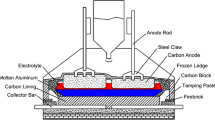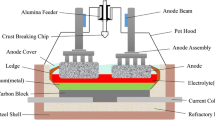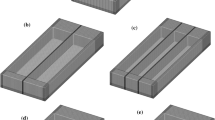Abstract
Numerical simulations of gas-liquid two-phase flow and alumina transport process in an aluminum reduction cell were conducted to investigate the effects of anode configurations on the bath flow, gas volume fraction and alumina content distributions. An Euler-Euler two-fluid model was employed coupled with a species transport equation for alumina content. Three different anode configurations such as anode without a slot, anode with a longitudinal slot and anode with a transversal slot were studied in the simulation. The simulation results clearly show that the slots can reduce the bath velocity and promote the releasing of the anode gas, but can not contribute to the uniformity of the alumina content. Comparisons of the effects between the longitudinal and transversal slots indicate that the longitudinal slot is better in terms of gas-liquid flow but is disadvantageous for alumina mixing and transport process due to a decrease of anode gas under the anode bottom surface. It is demonstrated from the simulations that the mixing and transfer characteristics of alumina are controlled to great extent by the anode gas forces while the electromagnetic forces (EMFs) play the second role.
Similar content being viewed by others
References
LIU Ye-xiang, LI Jie. Modern aluminum electrolysis [M]. Beijing: Metallurgical Industry Press, 2008: 69–77. (in Chinese)
ZHOU Nai-jun, XUE Yu-qing, CHEN J J, TAYLOR M P. Numerical simulation of electrolyte two-phase flow induced by anode bubbles in an aluminum reduction cell [J]. Chemical Product and Process Modeling, 2007, 11(2):1934–1945.
ZHOU Nai-jun, XIA Xiao-xia, WANG Fu-qiang. Numerical simulation on electrolyte flow field in 156 kA drained aluminum reduction cells [J]. Journal of Central South University, 2007, 14(1):42–46.
ZHANG Hong-liang, WANG Zhi-gang, LI Jie, LAI Yan-qing. Simulation on flow field of anode gas and electrolyte in aluminum electrolysis with cermet inert anodes [J]. Journal of Central South University: Science and Technology, 2010, 41(4): 1256–1262. (in Chinese)
ZHAN Shui-qing, ZHOU Jie-min, LI Mao, DONG Ying, ZHOU Yi-wen, YANG Jian-hong. Numerical simulation of gas-liquid two-phase flow in aluminum reduction cells with perforated anodes [J]. CIESC Journal, 2013, 64(10): 3612–3619. (in Chinese)
ZHAN Shui-qing, LI Mao, ZHOU Jie-min, YANG Jian-hong, ZHOU Yi-wen. A CFD-PBM coupled model predicting anodic bubble size distribution in aluminum reduction cells [C]// GOHN G. Light Metals 2014. San Diego: TMS, 2014: 777–782.
DOHEIM M A, ELKERSH A M, ALI M M. Computational modeling of flow in aluminum reduction cells due to gas bubbles and electromagnetic forces [J]. Metallurgical Materials Transactions B, 2007, 38(1):113–119.
ZHANG Kai-yu, FENG Yu-qing, SCHWARZ P, WANG Zhao-wen, COOKSEY M A. Computational fluid dynamics (CFD) modeling of bubble dynamics in the aluminum smelting process [J]. Industrial and Engineering Chemistry Research, 2013, 52(4):11378–11390.
FENG Y Q, COOKSEY M A, SCHWARZ M P. CFD modeling of alumina mixing in aluminium reduction cells [C]// HAGNI A M. Light Metals 2010. Seattle, WA: TMS, 2010:451–456.
FENG Y Q, COOKSEY M A, SCHWARZ M P. CFD modeling of alumina mixing in aluminium reduction cells [C]// LINDSAY J. Light Metals 2011. San Diego, CA: TMS, 2011:543–548.
THOMAS H. Numerical simulation and optimization of the alumina distribution in an aluminium electrolysis pot [D]. Lausanne: École Polytechnique Fédérale de Lausanne, 2011.
ZHANG He-hui. Numerical study of vortex flow of melts and transport process of alumina in aluminum reduction cells [D]. Changsha: Central South University, 2012. (in Chinese)
KAENEL R, ANTILLE J, ROMERIO M V, BESSON O. Impact of magnetohydrodynamic and bubbles driving forces on the alumina concentration in the bath of an Hall-Héroult cell [C]// BARRY S. Light Metals 2013. San Antonio: TMS, 2013:585–590.
ZHAN Shui-qing, LI Mao, ZHOU Jie-min, ZHOU Yi-wen, YANG Jian-hong. Numerical simulation of alumina concentration distribution in the melts of aluminum reduction cells [J]. The Chinese Journal of Nonferrous Metals, 2014, 24(10): 2658–2667. (in Chinese)
ZHAN Shui-qing, LI Mao, ZHOU Jie-min, YANG Jian-hong, ZHOU Yi-wen. CFD simulation of dissolution process of alumina in an aluminum reduction cell with two-particle phase population balance model [J]. Applied Thermal Engineering, 2014, 73(1):803–816.
DIAS H P, MOURA R R. The use of transversal slot anodes at ALBRAS melter [C]// KVANDE H. Light Metals 2005. San Francisco, CA: TMS, 2005:341–344.
SEVERO D S, GUSBERTI V, PINTO E C V, MOURO R R. Modeling the bubble driven flow in the electrolyte as a tool for slotted anode design improvement [C]// SORLIE M. Light Metals 2007. Orlando, FL: TMS, 2007: 287–292.
YANG W, COOKSEY M A. Effect of slot height and width on liquid flow in physical models of aluminum reduction cells [C]// SORLIE M. Light Metals 2007. Orlando, FL: TMS, 2007:451–456.
YANG Shuai, ZHANG Hong-liang, XU Yu-jie, ZHANG He-hui, ZOU Zhong, LI Jie, LAI Yan-qing. Effects of slot cutting at prebaked anodes on bubble elimination in aluminum reduction cell [J]. Journal of Central South University: Science and Technology, 2012, 43(12): 4617–4625. (in Chinese)
SATO Y, SADATOMI M, SEKOGUCI K. Momentum and heat transfer in two-phase bubble flow-I: Theory [J]. Int J Multiphase Flow, 1975, 7(2):167–177.
FLUENT Inc. Fluent 6.3 User’s Guide [EB/OL]. [2014-05-15]. http://aerojet.engr.ucdavis.edu/fluenthelp/html/ug/mainpre.htm.
COOKSEY M A, YANG W. PIV measurements on physical models of aluminum reduction cells [C]// GPALLOWAY T J. Light Metals 2006. Warrendale: TMS, 2006: 359–365.
Author information
Authors and Affiliations
Corresponding author
Additional information
Foundation item: Project(2010AA065201) supported by the High Technology Research and Development Program of China; Project(2013zzts038) supported by the Fundamental Research Funds for the Central Universities of China; Project(ZB2011CBBCe1) supported by the Major Program for Aluminum Corporation of China Limited, China
Rights and permissions
About this article
Cite this article
Zhan, Sq., Li, M., Zhou, Jm. et al. CFD simulation of effect of anode configuration on gas-liquid flow and alumina transport process in an aluminum reduction cell. J. Cent. South Univ. 22, 2482–2492 (2015). https://doi.org/10.1007/s11771-015-2776-3
Received:
Accepted:
Published:
Issue Date:
DOI: https://doi.org/10.1007/s11771-015-2776-3




